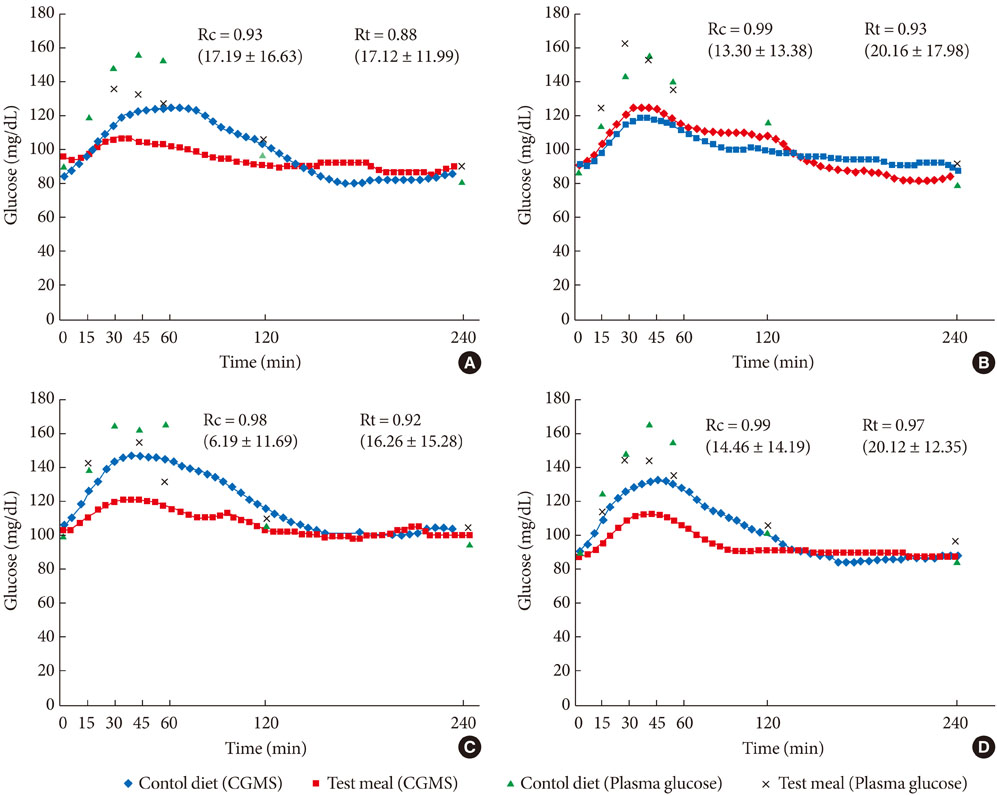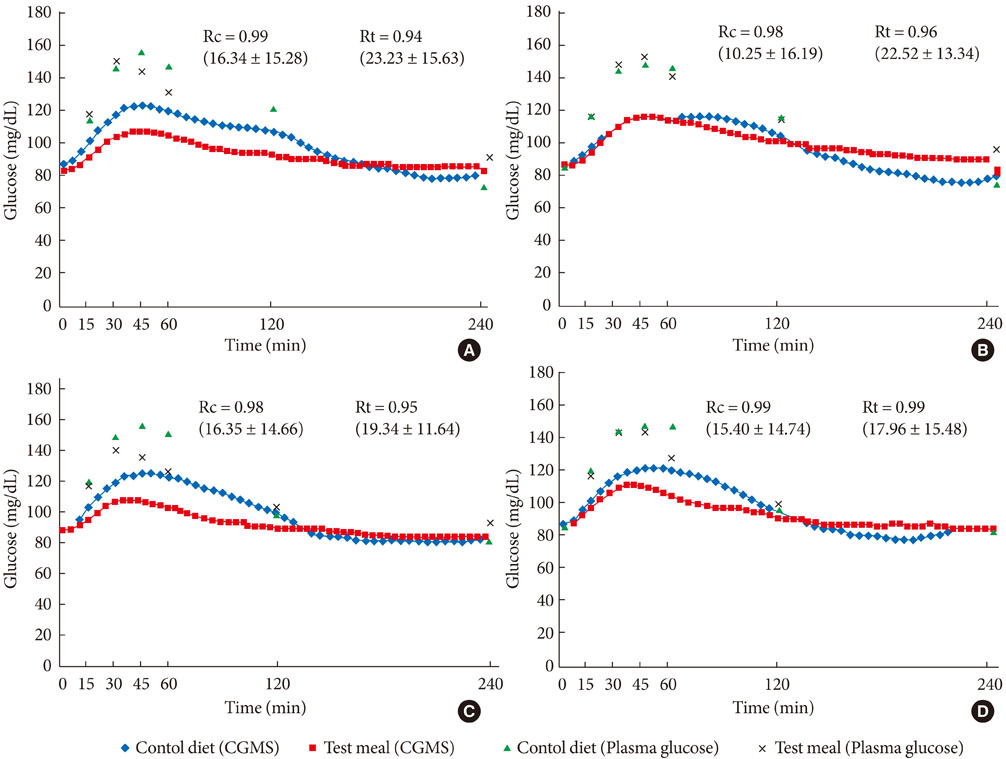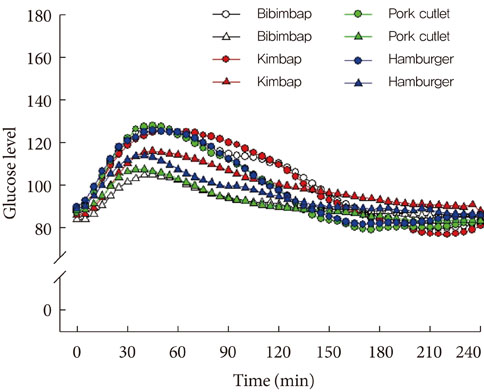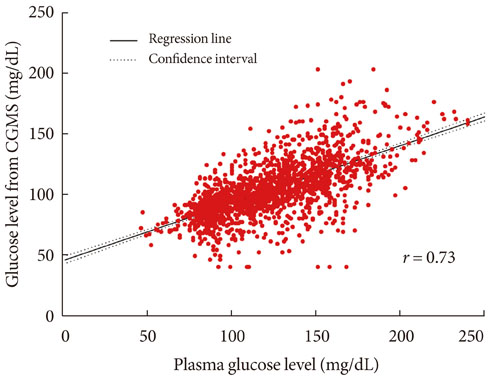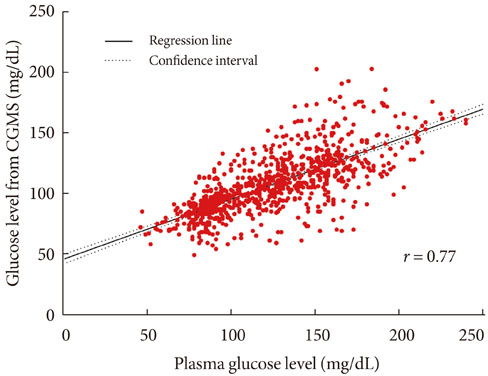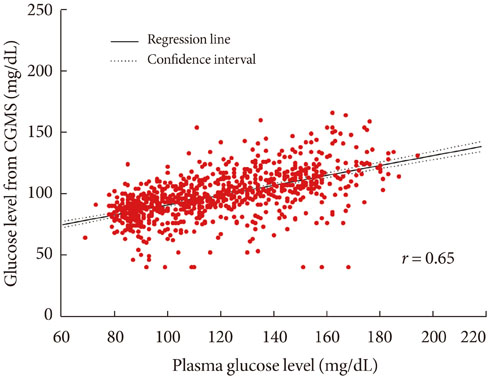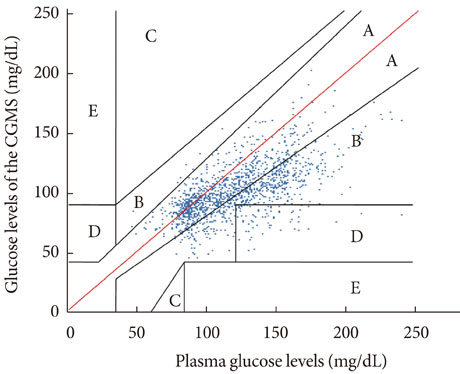Korean Diabetes J.
2010 Dec;34(6):350-358. 10.4093/kdj.2010.34.6.350.
The Correlation and Accuracy of Glucose Levels between Interstitial Fluid and Venous Plasma by Continuous Glucose Monitoring System
- Affiliations
-
- 1Division of Endocrinology and Metabolism, Department of Internal Medicine, Chonbuk National University Hospital, Chonbuk National University Medical School, Jeonju, Korea. pts@jbnu.ac.kr
- 2Department of Pharmacology, Chonbuk National University Medical School, Jeonju, Korea.
- 3Clinical Trial Center, Chonbuk National University Hospital, Chonbuk National University Medical School, Jeonju, Korea.
- KMID: 2222362
- DOI: http://doi.org/10.4093/kdj.2010.34.6.350
Abstract
- BACKGROUND
Clinical experience with the continuous glucose monitoring systems (CGMS) is limited in Korea. The objective of this study is to evaluate the accuracy of the CGMS and the correlation between interstitial fluid and venous plasma glucose level in Korean healthy male subjects.
METHODS
Thirty-two subjects were served with glucose solution contained same amount of test food's carbohydrate and test foods after separate overnight fasts. CGMS was performed over 3 days during hopitalization for each subjects. Venous plasma glucose measurements were carried out during 4 hours (0, 0.25, 0.5, 0.75, 1, 2, 4 hours) just before and after glucose solution and test food load. The performance of the CGMS was evaluated by comparing its readings to those obtained at the same time by the hexokinase method using the auto biochemistry machine (Hitachi 7600-110). Also, correlations between glucose recorded with CGMS and venous plasma glucose value were examined.
RESULTS
CGMS slightly underestimated the glucose value as compared with the venous plasma glucose level (16.3 +/- 22.2 mg/dL). Correlation between CGMS and venous plasma glucose values throughout sensor lifetime is 0.73 (regression analysis: slope = 1.08, intercept = 8.38 mg/dL). Sensor sensitivity can deteriorate over time, with correlations between venous blood glucose and CGMS values dropping from 0.77 during 1st day to 0.65 during 2nd and 3rd day.
CONCLUSION
The accuracy of data provided by CGMS may be less than expected. CGMS sensor sensitivity is decreased with the passage of time. But, from this study, CGMS can be used for glucose variability tendency monitoring conveniently to the Korean.
MeSH Terms
Figure
Reference
-
1. Juvenile Diabetes Research Foundation Continuous Glucose Monitoring Study Group. The effect of continuous glucose monitoring in well-controlled type 1 diabetes. Diabetes Care. 2009. 32:1378–1383.2. Cryer PE. Banting lecture. Hypoglycemia: the limiting factor in the management of IDDM. Diabetes. 1994. 43:1378–1389.3. Chico A, Vidal-Rios P, Subira M, Novials A. The continuous glucose monitoring system is useful for detecting unrecognized hypoglycemias in patients with type 1 and type 2 diabetes but is not better than frequent capillary glucose measurements for improving metabolic control. Diabetes Care. 2003. 26:1153–1157.4. Ludvigsson J, Hanas R. Continuous subcutaneous glucose monitoring improved metabolic control in pediatric patients with type 1 diabetes: a controlled crossover study. Pediatrics. 2003. 111(5 Pt 1):933–938.5. Chase HP, Kim LM, Owen SL, MacKenzie TA, Klingensmith GJ, Murtfeldt R, Garg SK. Continuous subcutaneous glucose monitoring in children with type 1 diabetes. Pediatrics. 2001. 107:222–226.6. Boland E, Monsod T, Delucia M, Brandt CA, Fernando S, Tamborlane WV. Limitations of conventional methods of self-monitoring of blood glucose: lessons learned from 3 days of continuous glucose sensing in pediatric patients with type 1 diabetes. Diabetes Care. 2001. 24:1858–1862.7. Danne T, Deiss D, Hopfenmuller W, von Schutz W, Kordonouri O. Experience with insulin analogues in children. Horm Res. 2002. 57:Suppl 1. 46–53.8. Weintrob N, Schechter A, Benzaquen H, Shalitin S, Lilos P, Galatzer A, Phillip M. Glycemic patterns detected by continu-ous subcutaneous glucose sensing in children and adolescents with type 1 diabetes mellitus treated by multiple daily injections vs continuous subcutaneous insulin infusion. Arch Pediatr Adolesc Med. 2004. 158:677–684.9. Bolinder J, Ungerstedt U, Arner P. Long-term continuous glucose monitoring with microdialysis in ambulatory insulin-dependent diabetic patients. Lancet. 1993. 342:1080–1085.10. Klonoff DC. Continuous glucose monitoring: roadmap for 21st century diabetes therapy. Diabetes Care. 2005. 28:1231–1239.11. Rhee SY, Kim YS, Oh S, Choi WH, Park JE, Jeong WJ. Diabcare Asia 2001-Korea: country report on outcome data and analysis. Korean J Intern Med. 2005. 20:48–54.12. Weinstein RL, Schwartz SL, Brazg RL, Bugler JR, Peyser TA, McGarraugh GV. Accuracy of the 5-day Free Style Navigator Continuous Glucose Monitoring System: comparison with frequent laboratory reference measurements. Diabetes Care. 2007. 30:1125–1130.13. Gross TM, Mastrototaro JJ. Efficacy and reliability of the continuous glucose monitoring system. Diabetes Technol Ther. 2000. 2:Suppl 1. S19–S26.14. Gross TM, Ter Veer A. Continuous glucose monitoring in previously unstudied population subgroups. Diabetes Technol Ther. 2000. 2:Suppl 1. S27–S34.15. Gross TM, Bode BW, Einhorn D, Kayne DM, Reed JH, White NH, Mastrototaro JJ. Performance evaluation of the MiniMed continuous glucose monitoring system during patient home use. Diabetes Technol Ther. 2000. 2:49–56.16. Bode BW, Gross TM, Thornton KR, Mastrototaro JJ. Continuous glucose monitoring used to adjust diabetes therapy improves glycosylated hemoglobin: a pilot study. Diabetes Res Clin Pract. 1999. 46:183–190.17. Tanenberg R, Bode B, Lane W, Levetan C, Mestman J, Harmel AP, Tobian J, Gross T, Mastrototaro J. Use of the Continuous Glucose Monitoring System to guide therapy in patients with insulin-treated diabetes: a randomized controlled trial. Mayo Clin Proc. 2004. 79:1521–1526.18. Sternberg F, Meyerhoff C, Mennel FJ, Mayer H, Bischof F, Pfeiffer EF. Does fall in tissue glucose precede fall in blood glucose? Diabetologia. 1996. 39:609–612.19. Kulcu E, Tamada JA, Reach G, Potts RO, Lesho MJ. Physiological differences between interstitial glucose and blood glucose measured in human subjects. Diabetes Care. 2003. 26:2405–2409.20. Gerritsen M, Jansen JA, Lutterman JA. Performance of subcutaneously implanted glucose sensors for continuous monitoring. Neth J Med. 1999. 54:167–179.21. Gerritsen M. Problems associated with subcutaneously implanted glucose sensors. Diabetes Care. 2000. 23:143–145.22. Gerritsen M, Jansen JA, Kros A, Vriezema DM, Sommerdijk NA, Nolte RJ, Lutterman JA, Van Hovell SW, Van der Gaag A. Influence of inflammatory cells and serum on the performance of implantable glucose sensors. J Biomed Mater Res. 2001. 54:69–75.
- Full Text Links
- Actions
-
Cited
- CITED
-
- Close
- Share
- Similar articles
-
- Correlations of Glucose Levels in Interstitial Fluid Estimated by Continuous Glucose Monitoring Systems and Venous Plasma
- Self-Monitoring Blood Glucose Meter: Is Your Glucose Meter Accurate?
- Application of Continuous Glucose Monitoring System (CGMS) and Patient Education
- Evaluation of a Novel Glucose Area Under the Curve (AUC) Monitoring System: Comparison with the AUC by Continuous Glucose Monitoring
- Comparison of Glucose Area Under the Curve Measured Using Minimally Invasive Interstitial Fluid Extraction Technology with Continuous Glucose Monitoring System in Diabetic Patients

